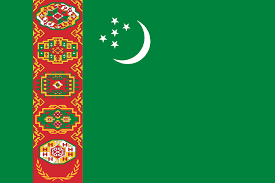Language/Turkmen/Grammar/Adjectives
Hi Turkmen learners! 😊
In this lesson, we will focus on Turkmen adjectives. Adjectives are an essential part of speech as they add detail and description to a sentence. In Turkmen, adjectives are used to modify or describe nouns, pronouns, or other adjectives. They also agree in gender, number, and case with the nouns they are modifying. We will cover all of these concepts and more, so let's get started!
Don't hesitate to look into these other pages after completing this lesson: The Case system, Future Tense, Conditional Mood & Question particle–my mi.
Forming Adjectives[edit | edit source]
In Turkmen, adjectives are generally formed by adding the suffix "-ly" to a noun. For example:
| Turkmen | Pronunciation | English |
|---|---|---|
| kitap | [kitaːp] | book |
| kitaply | [kitaːplɯ] | bookish/book-like |
| ýigit | [jiːɡit] | boy |
| ýigitli | [jiːɡitli] | boyish |
As you can see in the examples above, the suffix "-ly" is added to the end of the noun to form the adjective. It's important to note that sometimes additional letters might be added to the suffix "-ly," such as "s" or "t," depending on the ending of the original noun.
Agreement of Adjectives[edit | edit source]
Turkmen adjectives agree in gender, number, and case with the nouns they modify. This means that the ending of the adjective changes to match the ending of the noun.
Gender Agreement[edit | edit source]
In Turkmen, nouns are either masculine or feminine. Adjectives will have an -a ending if they are modifying a feminine noun and an -y ending if they are modifying a masculine noun. For example:
| Turkmen | Pronunciation | English |
|---|---|---|
| göz | [ɡœz] | eye |
| gözüň | [ɡœzyŋ] | his/her eye |
| gözeli | [ɡœzeli] | pretty (feminine) |
| köpek | [køpɛk] | dog |
| köpüň | [køpyŋ] | his/her dog |
| köpüni | [køpyni] | dog (accusative) |
| köpüňli | [køpyŋli] | dog-like (masculine) |
As shown in the examples above, the adjective "gözeli" has an -a ending because it's modifying the feminine noun "göz" (eye), while the adjective "köpüňli" has a -y ending because it's modifying the masculine noun "köpek" (dog).
Number Agreement[edit | edit source]
Adjectives in Turkmen also agree in number with the nouns they modify. If the noun is singular, the adjective also needs to be in the singular form, and if the noun is plural, the adjective needs to be in the plural form. For example:
| Turkmen | Pronunciation | English |
|---|---|---|
| gül | [ɡyl] | flower |
| gülüň | [ɡylʊŋ] | his/her flower |
| gülüňli | [ɡylʊŋli] | flowery |
| güller | [ɡyllɛr] | flowers |
| gülleriň | [ɡyllɛriŋ] | his/her flowers |
| gülleriňli | [ɡyllɛriŋli] | flowery (plural) |
In the examples above, you can see that the adjective "gülüňli" means "flowery," but when modifying the plural noun "güller" (flowers), it becomes "gülleriňli."
Case Agreement[edit | edit source]
Finally, adjectives also agree in case with the nouns they modify. This means that the ending of the adjective changes to match the case of the noun. For example:
| Turkmen | Pronunciation | English |
|---|---|---|
| ýol | [jol] | road |
| ýolyň | [jolʊŋ] | of the road |
| ýolaky | [jolɑkɯ] | road-like (nominative) |
| ýolakyň | [jolɑkɯŋ] | of road-like (genitive) |
In the example above, "ýolaky" is the nominative form of the adjective (meaning it's the subject of the sentence), while "ýolakyň" is the genitive form (meaning it's showing possession or relation).
Comparison of Adjectives[edit | edit source]
Adjectives in Turkmen can be compared using the suffixes "-da" (for comparative) and "-dan" (for superlative). For example:
| Turkmen | Pronunciation | English |
|---|---|---|
| iyi | [iji] | good |
| iýe-da | [ijiːe.dɑ] | better |
| iýe-dan | [ijiːe.dɑn] | best |
In the example above, "iýe-da" means "better," while "iýe-dan" means "best."
Dialogue[edit | edit source]
To help you better understand how adjectives are used in context, here's a dialogue between two friends:
- Friend 1: Salam, bugün hawa iýi. (Hello, the weather is nice today.)
- Friend 2: Hawa gowy däl ýaly dünýämiň en gyzykly hawa däl. (The weather isn't as good as the world's sweetest weather.)
- Friend 1: Özüň hawa barada hemmesi bilýär. (Everyone knows about the weather.)
- Friend 2: Ol ýokary howply. (It's extremely beautiful.)
Conclusion[edit | edit source]
That's it for this lesson on Turkmen adjectives! Remember, adjectives are a crucial component of Turkmen grammar and are used to add detail and description to sentences. By following the rules of gender, number, and case agreement, you can use adjectives like a native speaker. If you want to practice your skills, you can find native speakers and ask them any questions you might have. You can also check out other Turkmen Grammar lessons on Polyglot Club.
➡ If you have any questions, please ask them in the comments section below.
➡ Feel free to edit this wiki page if you think it can be improved. 😎
Great work on completing this lesson! Take a moment to investigate these connected pages: Word order, Pronouns and Verbs, Nouns & 0 to A1 Course.
Other Lessons[edit | edit source]
- Conditional Mood
- Pronouns
- Nouns
- Ordinal Numbers
- Future Tense
- Gender
- Personal pronouns
- How to Use Be
- The Subjunctive Mood
Sources[edit | edit source]

